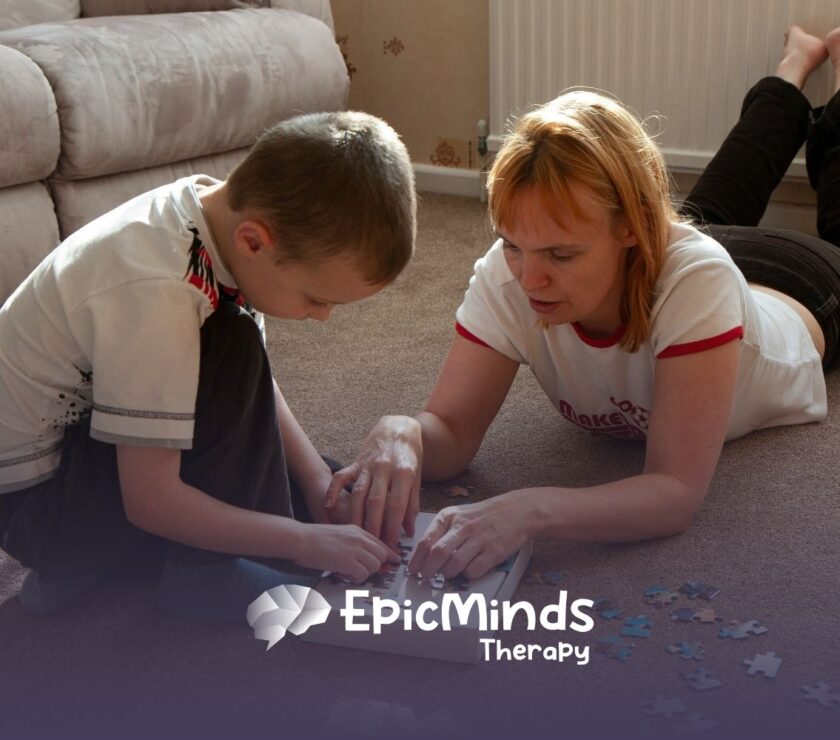Key Highlights
- Autism spectrum disorder (ASD) affects communication, behavior, and sensory sensitivity; personalized approaches can greatly improve a child’s quality of life.
- Predictable routines and clear boundaries bring stability and help reduce anxiety.
- Sensory-friendly spaces with tools like headphones and textured objects help kids manage sensory overload.
- Effective communication tools like PECS (Picture Exchange Communication System) and assistive technology can help nonverbal children express themselves.
- Social skills training and community participation help children build relationships and integrate into their communities.
Raising a child with autism requires a mix of patience, understanding, and strategy. Each child has their own unique needs, and what works for one child might not work for another. But no matter the challenges, there’s always a way forward.
I remember a family I supported whose young son had trouble with social interactions. In home-based ABA therapy, by focusing on small but meaningful changes—like creating a sensory-friendly space and setting clear routines—this family saw improvements in his ability to engage with others.
Their story shows how individualized approaches can work wonders.
In this blog, we’ll share practical tips that can help children with autism feel understood, safe, and supported as they grow and develop.
Creating a Supportive Home Environment
A nurturing, understanding home environment is crucial for children with autism. When parents and caregivers are attuned to their child’s needs, it can make everyday life smoother for the entire family.
The first step is to pay attention to what your child enjoys or responds well to, then find small but meaningful ways to help them feel more comfortable and supported at home.
Start by making your home a calm and predictable place. Simple changes can have a big impact. Focus on activities your child enjoys, and try to create an environment where they feel safe and secure. In the next section, we’ll talk about how you can use routines and boundaries to provide even more stability and comfort.
Establishing Predictable Routines and Boundaries
Children, especially those with autism, tend to do better when their days are predictable. A structured routine can help reduce anxiety and give them a sense of control over their environment.
One easy way to establish a routine is by using visual schedules. These can be as simple as picture cards or symbols that show what will happen next. Knowing what to expect gives children confidence and helps them feel more settled throughout the day.
Setting clear boundaries is just as important as establishing routines. Letting your child know what’s expected of them in a calm and consistent manner helps them understand what behaviors are acceptable.
It’s crucial to be patient, repeating instructions and reinforcing positive actions with rewards (like stickers or small treats). The earlier you start these routines, the easier it will be for your child to adjust. Starting around 12 months of age can be a good time to introduce basic structure.
Make sure everyone in the family is on board with the routines and boundaries. When caregivers are consistent, it makes a huge difference in helping your child thrive.
And, if routines need to change, take it slowly. Gradually introducing small changes helps your child adjust and builds their ability to handle transitions.
Designing Sensory-Friendly Spaces for Comfort and Growth
For many children with autism, managing sensory input can be a real challenge. Creating a sensory-friendly space at home can give them a quiet, safe place to relax, recharge, or engage in stimulating activities when they’re ready.
Creating a Sensory-Friendly Environment
Design a space that is calm and tailored to your child’s sensory needs. You might want to create a cozy corner with soft textures, calming lights, and soothing toys.
If your child struggles with noise, noise-canceling headphones or weighted blankets can help them feel more comfortable. Occupational therapy tools can also support your child’s ability to handle sensory input.
The key is to make the sensory space adaptable—give your child a place to be both active and relaxed. Add in things like aromatherapy diffusers or calming colors to help them unwind when needed.
A sensory-friendly space helps children regulate their sensory experiences and can make a big difference in their emotional well-being.
Effective Communication Strategies
Communication can be a challenge for children with autism, especially if they are nonverbal or minimally verbal. However, there are several tools and strategies that can help children express their needs, which makes it easier for them to connect with others.
Alternative Communication Methods
For children who have difficulty speaking, tools like Picture Exchange Communication Systems (PECS) or assistive technology can help them communicate. With PECS, children use pictures or symbols to convey messages, like asking for food or expressing emotions.
For other children, AAC devices, like tablets or apps that generate speech, can give them the power to express their thoughts and desires.
The key to using these communication methods effectively is consistency. It may take some time for your child to learn how to use these tools, but with patience, they’ll begin to express themselves more confidently.
Supporting Nonverbal or Minimally Verbal Children
If your child is nonverbal or minimally verbal, consider the following strategies:
- PECS: Use pictures or symbols to help children communicate basic needs, like asking for food or expressing feelings.
- Encourage Eye Contact: Prompting eye contact during interactions can help build connection and understanding.
- AAC Devices: Tablets or apps that generate speech can help your child express themselves if they have difficulty speaking.
- Modeling Communication: Show your child simple communication methods, such as pointing or waving, and build from there.
Using these methods consistently will help your child develop their communication skills over time. With practice, they’ll feel more comfortable expressing themselves.
Using Visual Supports and Assistive Technology
Visual supports and assistive technology can significantly improve how children with autism understand their environment and communicate with others. These tools can make daily routines easier to navigate and help children feel more confident.
| Visual Aid | How It Helps |
| PECS (Picture Exchange Communication System) | Helps children express their needs or desires through images. |
| Social Stories | Teaches children what to expect in new or unfamiliar situations. |
| AAC Devices (Augmentative and Alternative Communication) | Tablets or apps generate speech for children who are nonverbal. |
| Visual Schedules | Uses pictures or symbols to show a child what to expect during their day. |
These tools help reduce anxiety, foster independence, and encourage social interaction.
Promoting Social Skills and Community Inclusion
Social skills are essential for building relationships and making friends. Many children with autism find social situations challenging, but with the right support, they can learn how to interact and connect with others.
Building Social Skills Through Interaction
Start by encouraging social interactions in structured settings, like social skills groups, where children can practice turn-taking and other social behaviors. Social stories can help children prepare for new situations by explaining what to expect, making social events feel less intimidating.
Encourage peer interactions through playdates or community events. These informal settings provide a natural opportunity for children to practice their social skills in a relaxed environment.
Over time, these experiences can help children become more comfortable with others, whether in school or at community events.
Encouraging Participation in Community Activities
Community activities, like local sports leagues or arts programs, give children the chance to learn new skills while also engaging with their peers. These activities aren’t about competition—they’re about building confidence, learning, and having fun.
When your child participates in community activities, they become more comfortable in group settings. Positive reinforcement, like praise or small rewards, can encourage them to keep participating and try new things.
Conclusion
Supporting children with autism requires a personalized approach. By focusing on routines, sensory needs, communication strategies, and social skills, you can help your child grow, thrive, and feel more confident. It takes time, patience, and flexibility, but every small step you take can make a huge difference in their life.
Remember, it’s all about finding what works best for your child and being open to trying new strategies as they grow. You don’t have to do it alone—seek support when needed and never hesitate to ask for help from professionals.
If you’d like personalized advice on how to support your child with autism, don’t hesitate to reach out to Epic Minds. Our personalized ABA (Applied Behavior Analysis) therapy services are designed to address your child’s unique needs and provide them with the tools to thrive.
Whether you need help with social skills, communication, or daily routines, our team of specialists can guide you every step of the way.
Frequently Asked Questions
What therapies are most effective for children with autism?
Therapies like Applied Behavior Analysis (ABA), Cognitive Behavioral Therapy (CBT), and occupational therapy are commonly used. Working with healthcare professionals who specialize in autism can help you develop a plan tailored to your child’s needs.
How can parents help their autistic child develop independence?
Encourage small, manageable tasks and use positive reinforcement to celebrate each success. Start with simple skills and gradually increase the complexity. Involve other family members to ensure consistent support and encouragement.
Are there recommended resources for families in the US?
Resources such as Autism Speaks, the American Academy of Pediatrics, and the National Autistic Society provide valuable information. The CDC website and other national organizations offer great tools for caregivers.
How do I support my child during transitions or changes?
Visual cues, social stories, and maintaining a consistent routine can help your child adjust to changes. Work with their teachers and use Individualized Education Plans (IEPs) to make transitions smoother.
Can children with autism attend mainstream schools?’
Yes, many children with autism thrive in mainstream schools with the right support, such as IEPs. It’s essential to collaborate with educators and healthcare providers to determine what’s best for your child’s needs.
Sources:
- https://www.helpguide.org/mental-health/autism/helping-your-child-with-autism-thrive
- https://www.autismspeaks.org/blog/five-tips-helped-improve-my-childs-behavior
- https://www.urmc.rochester.edu/encyclopedia/content?contenttypeid=160&contentid=46
- https://www.unicef.org/eca/stories/how-support-your-child-autism
- https://www.autismspeaks.org/tool-kit-excerpt/autism-classroom-strategies




